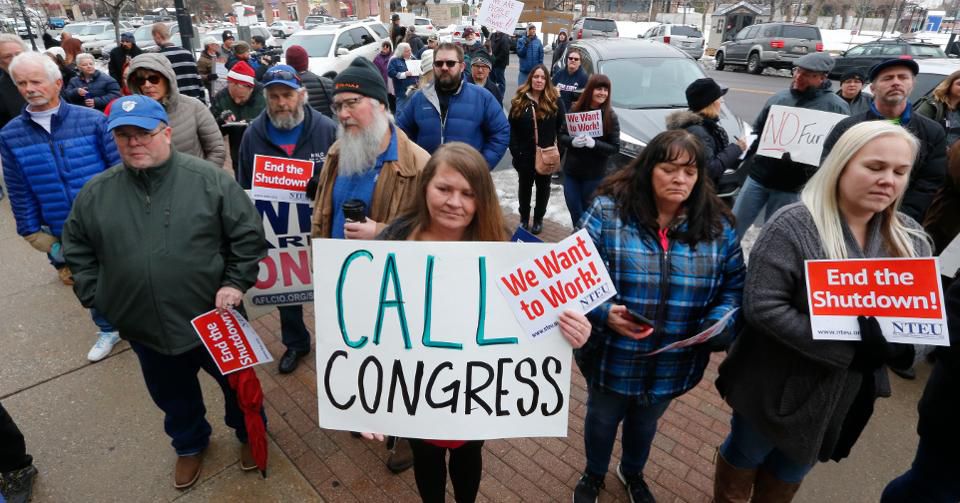The Economic Implications of a Government Shutdown– and its Border Wall
The United States government has remained shut down since midnight December 22, 2018 due to an impasse between the Democratic and the Republican parties over the Congressional allocation of funding. The issue is that they cannot come to an agreement over whether President Trump’s (Republican) proposed wall at the Mexican border will be included in Congressional spending. The wall, estimated to cost 5.7 billion dollars, is intended to discourage illegal immigration to the United States, a controversial topic in recent times due to the political and economic repercussions associated with black labor and the black market illegal immigration generates. Despite these detriments, the government shutdown has affected its own economic failings upon the nation and the border wall– if approved– will set in motion a novel (and more destructive) crop of economic lapses.
Government workers have been left unpaid during the government shutdown. For those who rely on a timely paycheck, the shutdown has inflicted financial stress upon their families and obligated some to take out loans until salaries are paid. Workers deemed “essential”, such as airport employees, must continue working without a paycheck while those delegated “non-essential” do not work, yet they are unable to seek temporary employment elsewhere because they are already technically employed by the government. Although government shutdowns inflict serious financial burdens upon government-employed individuals, the consequences of workers without salaries snowball and eventually cause deterioration in the national economy.
When workers do not have access to money to consume goods and services, the nation’s real GDP decreases because consumer spending, especially when there are roughly 800,000 unpaid employees according to Forbes, consists of a large part of U.S. real GDP. Despite the chance that President Trump’s proposed border wall (whose economic implications will be discussed later should it be approved) could potentially offset at least part, if not all, of the losses in consumer spending by increasing government spending, the economy will likely suffer a downturn in real GDP once the government shutdown ends. Although the government shutdown affects a minority of the American population, changes in real GDP (for the worse) can harm the entire nation. If consumers become more pessimistic about their current level of income, aggregate demand will decrease and real GDP will fall below the equilibrium output. Since essential government workers have no incentive to provide quality services, their productivity falls and there are less goods and services supplied in the short run. Not only is the quantity of services provided curtailed, but the health and safety of the nation is damaged when workers lose the motivation to provide quality services. For example, the TSA, which screens people for illegal and dangerous substances, plays a crucial role in airport security, but when workers start calling in sick because they are not being paid for their work and standard procedures are not followed for screening passengers, this results in incidents such as the one on January 3rd 2019 on a flight from Atlanta to Tokyo in which a passenger was allowed to board the plane carrying a firearm.
The government shutdown itself if harmful enough, but the object of dispute- President Trump’s proposed 5.7 billion dollar border wall- would further depress the economy. The wall (if proven effectual) will keep out illegal immigrants who compose a large population of the United States (a Pew Research Center report estimates 10.7 million in fact, in 2017 there was a record low of illegal immigration to the U.S.) and are a major source of economic support. Should the illegal immigrant supply vanish, there would be loss of production of resources, which would decrease long run aggregate supply and real GDP for the United States. In addition, illegal immigrants still pay taxes to the government, so if millions of tax dollars were lost, considerable national wealth and the U.S.’s position as a global superpower would be diminished.
Although it could be argued that those who are unemployed will replace these lost workers’ jobs, the national unemployment rate is at a relative low of 3.9% according to the Bureau of Labor Statistics, a very low number considering anything below 5% unemployment signals economic welfare. Part of this unemployment rate could simply be due to people sitting on job offers because they have the experience and qualifications to find a better offer, and others could have experience and backgrounds which differ from the positions deserted by illegal immigrants. Those who are stalling accepting a job due to the high wage and benefit competition between employers are considered part of the frictionally unemployed, while those who are unable to find any job because there is a shortage of jobs available for the existing labor supply. During times of low unemployment, frictional unemployment, rather than structural, composes the majority of unemployment, so in reality, there is no great surplus of jobs that would be created should illegal immigrants’ jobs open up to the legally unemployed.
Despite the possible benefit to real GDP which government spending on a wall would impart upon the American economy, and since the economy is currently doing well (as partly demonstrated by the low unemployment rate) Keynesian economic theory would advise against spending money during periods of economic growth. From an economic vantage point, it appears neither the border wall itself nor the government shutdown resulting from the political disagreement over the wall’s construction would be an economic asset to the United States.
Sources:
https://www.cbsnews.com/news/government-shutdowns-damage-to-u-s-economy-to-soon-exceed-5-7-billion-cost-of-trumps-border-wall/
https://www.cnn.com/2018/12/28/politics/shutdown-second-week/index.html
https://www.forbes.com/sites/dantedisparte/2019/01/11/the-longest-u-s-government-shutdown/#59ef5e9669e5
https://www.washingtonpost.com/transportation/2019/01/14/passenger-with-gun-made-it-through-tsa-checkpoint-atlanta-onto-delta-flight/?noredirect=on&utm_term=.43a59be22e6f
http://www.pewresearch.org/fact-tank/2018/11/30/key-findings-about-u-s-immigrants/
https://data.bls.gov/timeseries/lns14000000

